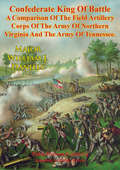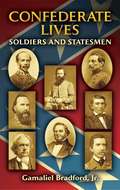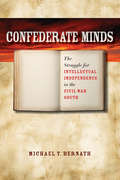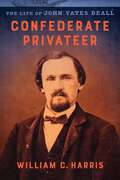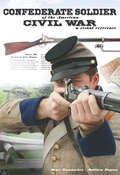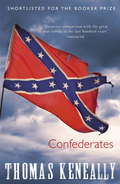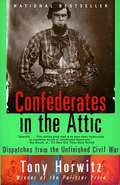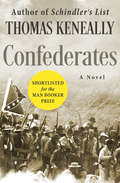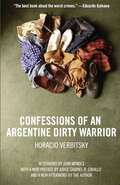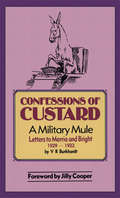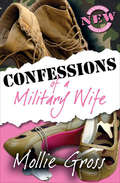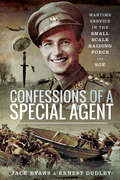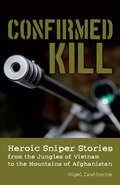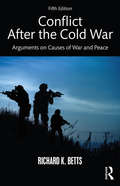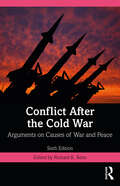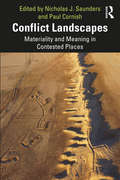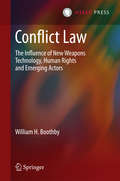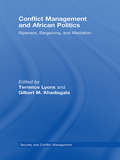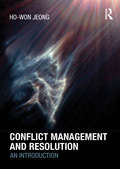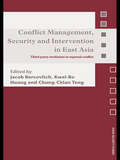- Table View
- List View
Confederate King Of Battle: A Comparison Of The Field Artillery Corps Of The Army Of Northern Virginia And The Army Of Tennessee
by Major William J. DanielsThis thesis compares and contrasts the field artillery corps of the Army of Northern Virginia and the Army of Tennessee. The purpose is to determine which field artillery corps was more effective on the battlefield and why. To answer this question several areas will be examined. The foundation of each army and its field artillery corps is one of these areas. The foundation includes militia forces, strength, recruiting, and governmental roles in the foundation of each army. The senior leadership of each army and its relationship with the Confederate government will be reviewed. Ordnance, equipment, logistics, and training of each army's field artillery corps are other areas that will be addressed. Finally, artillery leadership, organization, and tactics of each field artillery corps will be examined.
Confederate Lives: Soldiers and Statesmen (Civil War)
by Gamaliel BradfordThe distinguished historian Gamaliel Bradford, Jr.--author of Lee, the American and other acclaimed Civil War biographies--offers portraits of eight key leaders of the Confederacy. Bradford's skills at compiling concise profiles are at their finest in these compelling sketches of prominent figures in the Southern Cause.Commanding officers include Joseph E. Johnston, the highest-ranking U.S. Army officer to resign and join the Confederacy; the war's most famous cavalryman, J. E. B. Stuart; Lee's "Old War Horse," James Longstreet, who served from Manassas to Appomattox; P. G. T. Beauregard, winner of the nearly bloodless victory at Fort Sumter; and Rear Admiral Raphael Semmes, so successful in battle that he was charged at the war's end with treason and piracy. Confederate statesmen include U.S. Senator Judah P. Benjamin, appointed by Jefferson Davis as Confederate attorney general, secretary of war, and secretary of state; Vice-President of the Confederate States, Alexander H. Stephens; and Senator Robert Toombs, who evolved from conservative Unionist to ardent secessionist.The book concludes with the "high water mark" of the Confederacy at Gettysburg and examines the effects of that momentous battle. Previously available only in expensive, hard-to-find editions, this volume is a rare find for Civil War buffs.
Confederate Minds: The Struggle for Intellectual Independence in the Civil War South
by Michael T. BernathDuring the Civil War, Confederates fought for much more than their political independence. They also fought to prove the distinctiveness of the Southern people and to legitimate their desire for a separate national existence through the creation of a uniquely Southern literature and culture. In this important new book, Michael Bernath follows the activities of a group of Southern writers, thinkers, editors, publishers, educators, and ministers--whom he labels Confederate cultural nationalists--in order to trace the rise and fall of a cultural movement dedicated to liberating the South from its longtime dependence on Northern books, periodicals, and teachers. During the Civil War, Confederates fought for much more than their political independence. They also fought to prove the distinctiveness of the Southern people and to legitimate their desire for a separate national existence through the creation of a uniquely Southern literature and culture. In this important new book, Michael Bernath follows the activities of a group of Southern writers, thinkers, editors, publishers, educators, and ministers--whom he labels Confederate cultural nationalists--in order to trace the rise and fall of a cultural movement dedicated to liberating the South from its longtime dependence on Northern books, periodicals, and teachers. This struggle for Confederate "intellectual independence" was seen as a vital part of the larger war effort. For the Southern nationalists, independence won on the battlefield would be meaningless as long as Southerners remained in a state of cultural "vassalage" to their enemy. As new Confederate publications appeared at a surprising rate and Southerners took steps toward establishing their own system of education, cultural nationalists believed they saw the Confederacy coalescing into a true nation. Ultimately, however, Confederates proved no more able to win their intellectual independence than their political freedom. By analyzing the motives driving the struggle for Confederate intellectual independence, by charting its wartime accomplishments, and by assessing its failures, Bernath makes provocative arguments about the nature of Confederate nationalism, life within the Confederacy, and the perception of Southern cultural distinctiveness.
Confederate Privateer: The Life of John Yates Beall
by William C. HarrisConfederate Privateer is a comprehensive account of the brief life and exploits of John Yates Beall, a Confederate soldier, naval officer, and guerrilla in the Chesapeake Bay and Great Lakes region. A resident of Charles Town, Virginia (now West Virginia), near Harpers Ferry, Beall was a member of the militia guarding the site of John Brown’s execution in 1859. Beall later signed on as a private in the Confederate army and suffered a wound in defense of Harpers Ferry early in the war. He quickly became a fanatical Confederate, ignoring the issue of slavery by focusing on a belief that he was fighting to preserve liberty against a tyrannical Republican party that had usurped the republic and its constitution.Limited by poor health but still seeking an active role in the Confederate cause, Beall traveled to the Midwest and then to Canada, where he developed an elaborate plan for Confederate operations on the Great Lakes. In Richmond, Beall laid his plan before Confederate President Jefferson Davis and Secretary of the Navy Stephen Mallory. Instead of the Great Lakes operation, Mallory authorized a small privateering action on the Chesapeake Bay. Led by “Captain” Beall, the operation damaged or destroyed several ships under the protection of the U.S. Navy. For his part in organizing the raids, Beall became known as the “Terror of the Chesapeake.”After Union forces captured Beall and his men, the War Department prepared to try them as pirates. But Secretary of War Edwin Stanton backed down, and Beall was later freed in a prisoner exchange. Organizing another privateering operation on the Great Lakes, Beall had some early successes on the water. He then hatched a plan to derail a passenger train transporting Confederate prisoners of war near Niagara, New York, but was captured before he could carry out the mission. The Union army charged Beall with conspiracy, found him guilty, and executed him.Harris’s history of Beall offers a new view of paramilitary efforts by civilians to support the Confederacy. Though little remembered today, Beall was a legendary figure in the Civil War South, so much so that his execution was on John Wilkes Booth’s list of reasons to assassinate President Abraham Lincoln. Based on exhaustive research in primary and secondary sources and placed in the context of more extensive Confederate guerrilla operations, Confederate Privateer is sure to be of interest to Civil War scholars and general readers interested in the conflict.
Confederate Scout: Virginia’s Frank Stringfellow
by James Dudley PeaveyHere are gathered together some of the adventures and experiences of that already legendary Virginian, Frank Stringfellow; by himself and by others who knew him well. Born June 18, 1840, the days of his early twenties, from 1861 to 1865—almost 100 years ago—were not lacking in excitement.In the Spring of 1861, young Frank Stringfellow returned home from Mississippi to offer his services to Virginia and the Confederacy. At this time he was not of strong physical constitution, and it was only after repeated attempts to enlist that he was accepted in the “Powhatan Troop” of the Virginia Cavalry, on May 28, 1861, at Culpeper, Virginia. It is remarkable that he was able to withstand the rigors of service as a scout and partisan; but it seems his physical condition gradually improved under the stimulation of his active life.On detached service as a scout almost from the beginning with Capt. Lay of the Powhatan Troop at Manassas; he was soon to gain the attention and confidence of Gen. J. E. B. Stuart, the Cavalry Commander. As his accomplishments and the value of his services increased, he was also held in high regard by Gen. Wade Hampton and Gen. Fitzhugh Lee, of the Cavalry.Before long, his ability and services attracted the attention of Gen. Robert E. Lee. For him, and the cause of the Confederacy, in spite of his youth, Frank Stringfellow performed invaluable service as a scout. He was proud to be called ‘Lee’s Scout.’
Confederate Soldier of the American Civil War: A Visual Reference
by Denis Hambucken Chris BenedettoThis book provides a glimpse at the lives, weapons, and equipment of these soldiers through a collection of artifacts and exacting reproductions. As 1862 dawned, the Civil War, the conflict that had started the year before and that most Americans thought would last only a few months, showed no signs of ending. Hundreds of thousands of men across the divided nation enlisted in state volunteer regiments that poured into the sprawling military camps around Washington, DC, Richmond, Virginia, and other strategic locations. Within a year, thousands of these courageous men had lost their lives on bloody battlefields or died in disease-ridden encampments. This book provides a glimpse at the lives, weapons, and equipment of these soldiers through a collection of artifacts and exacting reproductions. While other books examine the War Between the States from a political, tactical, or military perspective, these books focus on the day-to-day life and the human experience of the men themselves, the Union and Confederate soldiers who enlisted and often fought to the death for their beliefs and those of their home regions of the young United States. Illustrated with full-color photography and historical documents, engagingly written and thoroughly explained, these books are the perfect addition to children’s and adults’ library collections, school libraries, and personal libraries of interested readers and history lovers of all ages.
Confederate Staff Work At Chickamauga: An Analysis Of The Staff Of The Army Of Tennessee
by Major Robert L. JohnsonOne of the critical variables in the successful completion of a military campaign is the functioning of an army's command and control system. In the American Civil War, a commander's primary command and control tool was his staff.Large Civil War armies like the Army of Tennessee required significant numbers of staff personnel. Staffs existed at each level of command from regiment through the army level. Staff officers had responsibility in three broad areas: personnel and logistical support to the army, military administration, and command and control.This thesis analyzes the roles, functional organization, and performance of the staff of the Army of Tennessee and its subordinate corps during the Chickamauga campaign, 16 August-22 September 1863. Primary sources for staff personnel include the Official Records of the Union and Confederate Armies, and the Compiled Service Records of staff officers. Staff performance is evaluated in terms of doctrine and practices as embodied in regulations and military literature of the day.This thesis concludes that, while staff performance was adequate in administration and logistical support, the performance of the command and control system was inadequate. The staff's failure in this area had a significant negative impact on the performance of the army as a whole.
Confederates
by Thomas KeneallyAs the Civil War tears America apart, General Stonewall Jackson leads a troop of confederate soldiers towards the battle they believe will be a conclusive victory. Through their hopes, fears and losses, Keneally searingly conveys both the drama and mundane hardship of war, and brings to life one of the most emotive episodes in American history.
Confederates in the Attic: Dispatches from the Unfinished Civil War (Vintage Departures)
by Tony HorwitzNational Bestseller. When prize-winning war correspondent Tony Horwitz leaves the battlefields of Bosnia and the Middle East for a peaceful corner of the Blue Ridge Mountains, he thinks he's put war zones behind him. But awakened one morning by the crackle of musket fire, Horwitz starts filing front-line dispatches again this time from a war close to home, and to his own heart. Propelled by his boyhood passion for the Civil War, Horwitz embarks on a search for places and people still held in thrall by America's greatest conflict. The result is an adventure into the soul of the unvanquished South, where the ghosts of the Lost Cause are resurrected through ritual and remembrance. In Virginia, Horwitz joins a band of 'hardcore' re-enactors who crash-diet to achieve the hollow-eyed look of starved Confederates; in Kentucky, he witnesses Klan rallies and calls for race war sparked by the killing of a white man who brandishes a rebel flag; at Andersonville, he finds that the prison's commander, executed as a war criminal, is now exalted as a martyr and hero; and in the book's climax, Horwitz takes a marathon trek from Antietam to Gettysburg to Appomattox in the company of Robert Lee Hodge, an eccentric pilgrim who dubs their odyssey the 'Civil Wargasm.' Written with Horwitz's signature blend of humor, history, and hard-nosed journalism, Confederates in the Attic brings alive old battlefields and new ones 'classrooms, courts, country bars' where the past and the present collide, often in explosive ways. Poignant and picaresque, haunting and hilarious, it speaks to anyone who has ever felt drawn to the mythic South and to the dark romance of the Civil War.
Confederates: A Novel
by Thomas KeneallyAs the Civil War tears America apart, General Stonewall Jackson leads a troop of confederate soldiers towards the battle they believe will be a conclusive victory. Through their hopes, fears and losses, Keneally searingly conveys both the drama and mundane hardship of war, and brings to life one of the most emotive episodes in American history.
Confederates: A Novel
by Thomas KeneallyA powerful novel of America's Civil War told through the voices of Confederate soldiers, turncoats, and Stonewall Jackson in the weeks leading up to the great slaughter at Antietam In the summer of 1862, as the Civil War rages on, a ragtag Confederate army consisting of young boys and old men, storekeepers, farmers, and teachers, gathers in Virginia under the leadership of Tom "Stonewall" Jackson, ready to follow their sainted commander to glory--or hell. One of these men, Usaph Bumpass left his wife, Ephie, behind to join the Shenandoah Volunteers, only to discover Ephie's lover, Decatur Cate, among his comrades. Still, Usaph remains steadfast in his devotion to a cause he does not fully understand, even as troubling memories of home invade his mind on the march north. But a dark destiny awaits brilliant military strategist Jackson and his Southern boys, as hard truths about war, loyalty, love, life, and death are revealed in the fires and bloodshed at Antietam. A breathtaking work of historical fiction that captures the human face of war as few novels have done before, Confederates has been compared to Tolstoy's epic War and Peace as an artful, honest, and profoundly moving depiction of the lot of the soldier. Shortlisted for Great Britain's prestigious Man Booker Prize, this masterful tale of love, duty, and conflict from author of Schindler's List Thomas Keneally is an enduring and unforgettable classic of Civil War literature.
Confessions Of An Argentine Dirty Warrior: A Firsthand Account Of Atrocity
by Horacio VerbitskyRetired navy officer Adolfo Scilingo was the first man ever to break the Argentine military's pact of silence, stunning his compatriots and the world by openly confessing his participation in the hideous practice of pushing live political dissidents out of airplanes during Argentina's dirty war. Available for the first time in paperback, with a new introduction by Judge Gabriel Cavallo on the upcoming military trials and a new epilogue by the author, Confessions of an Argentine Dirty Warrior includes the complete text of Scilingo's confession in the form of interviews given to Argentina's best-known investigative journalist, Horacio Verbitsky, along with an afterword by Juan Méndez, putting these events in the context of the dirty war.
Confessions of Custard: A Military Mule, Letters to Merrie and Bright, 1929-1932
by V. R. BurkhardtThis book is based on a collection of letter s about army life, written by Custard, a British Army mule working with a Royal Signal regiment between 1929 and 1932. Custard was actually Colonel V.R. Burkhardt, writing to his 2 nieces. '
Confessions of a Military Wife
by Mollie GrossNEW: UPDATED AND EXPANDED. Confessions of a Military Wife is an honest, witty, and often hilarious look at the life of the new generation military wife. Mollie Gross learned the hard way to laugh instead of cry at what she could not control as a military spouseand as she quickly discovered, nearly everything was out of her control!A standup comedienne, public speaker, and wife of a Marine Corps officer, Mollie explores everything about the issued spouse, from deployment and the stress of having a husband in a combat zone, to the realization that marriage changes when your husband returns home from war. Nothing is taboo or out-of-bounds in Confessions, including the parties military wives throw for themselves before hubby returns. (Youll have to read the book to find out about those!) Updated, expanded, and now in paperback, Confessions is a cant-put-down book that will leave you laughing and crying at the same time.About the Author: Mollie Gross is a professional stand-up comedienne, motivational speaker, and the wife of a USMC Iraq War veteran. She teaches audiences to Handle it with Humor to learn how to laugh through lifes toughest challenges. To follow her on social media, listen to her podcast, or inquire about booking, please visit www.molliegross.com. Mollie Gross is the Chelsea Handler of the milspouse community. Shes unfiltered, honest, and hilarious, with an underlying message to stop whining and be proud. Think of it as heartfelt humor for the home front. Military Spouse magazineMollies no-holds-barred account of what it was like during her first four years of being married to a Marine, dealing with the moves, wartime deployments, and life on the home front, will leave you laughing, crying, and shaking your head in disbelief asking, Did she really just say that!? Kristine Schellhaas, founder USMC Life
Confessions of a Special Agent: Wartime Service in the Small Scale Raiding Force and SOE
by Ernest Dudley Jack EvansMany are the tales of young men lying about their age to join the Army, yet Jack Evans sought far more at the age of just possibly just seventeen to act behind enemy lines as an agent of the Special Operations Executive.Evans had joined the RAF in 1940, despite being well under the legal age, and two years later was recruited into the SOE as a member of the Small Scale Raiding Force. Evans related his experiences with the SOE to author Ernest Dudley in the 1950s, in which he describes his training, including learning how to jump by parachute in preparation for an operation into France though he was withdrawn from the operation when his true age was disclosed. He then joined the SSRF, taking part in a number of raids upon Occupied France.Evans was then transferred to the Brandon Mission in Africa. This involved an eight-man team being parachuted into Tunisia to attack a railway line. In 1943 he was promoted to the rank of captain and parachuted into France, only to be captured by the Germans and imprisoned in Stalag Luft III for the remainder of the war.Evans suffered considerable mental trauma from his time behind enemy lines and his internment at the hands of the Germans and was unable to settle into normal civilian life. His astonishing story, written so soon after the end of the war, was considered in many respects to be ahead of its time.
Confessions of the Old Wizard: The Autobiography of Hjalmar Horace Greeley Schacht
by Hjalmar Horace Greeley SchachtConfessions of the Old Wizard: The Autobiography of Hjalmar Horace Greeley Schacht offers a fascinating and candid account of one of the most enigmatic and influential figures in 20th-century European finance and politics. Known as "the Old Wizard" for his financial acumen, Schacht played a pivotal role in stabilizing the German economy during the interwar period and later became a controversial figure due to his involvement with the Nazi regime.In this compelling memoir, Schacht recounts his remarkable career, beginning with his early life and education, which shaped his economic philosophy and pragmatic approach to fiscal policy. He provides a firsthand account of his tenure as President of the Reichsbank and Minister of Economics, detailing his efforts to combat hyperinflation, revive the German economy, and negotiate reparations after World War I.Schacht also addresses his uneasy relationship with Adolf Hitler and the Nazi leadership, offering insights into his disagreements with their policies and his eventual dismissal. His reflections on the trials at Nuremberg, where he was acquitted of war crimes, provide a unique perspective on one of history’s darkest periods.With a mix of self-reflection, historical commentary, and personal anecdotes, Confessions of the Old Wizard sheds light on the complexities of Schacht’s life and legacy. It reveals the intricate interplay between economics, politics, and morality during times of national and global upheaval.This autobiography is an essential read for those interested in economic history, the dynamics of power, and the moral dilemmas faced by individuals in positions of influence. Schacht’s narrative offers a rare glimpse into the life of a man who shaped—and was shaped by—the turbulent events of his time.
Confiar nas Trevas
by Elvira Sousa Eva FairwaldNão é vergonha nenhuma preferir a vida à morte, principalmente se a vingança se atravessa no caminho.Desta vez, a guerra significa renascimento, apesar de ser a consequência de um longo pesadelo perdido. A Capitão Ella Dorsh é dura, competente e ... indomável. Ela tem a certeza que o inimigo está a dominar o jogo e que a guerra, em breve, irá atingir a superfície, mas os humanos ainda não estão prontos para isso. O Reino Subterrâneo está enfraquecido e a população de elfos negros quer conquistar o mundo e governar. Ella e as "Divisões de Renascidos" são a única hipótese de lutarem contra o inimigo ao mesmo nível: elfos contra elfos para que as preciosas vidas humanas sejam poupadas. Contudo, nada é assim tão simples como parece, e as trevas escondem muito mais do que Ella alguma vez possa ter imaginado. O enredo passa-se no nosso mundo num futuro próximo, recheado de elementos de ficção científica e distópicos, sob a liderança de uma mulher que, certamente, vai surpreender todos leitores! Esta novela relata os esforços dos soldados elfo, apanhados no meio de algo demasiado grande para ser evitado, assim como perigosos segredos que irão mudar a vida e a história para sempre. Excertos: «Não é a morte o pesadelo sem cara que vos aterroriza em cada minuto das vossas vidas? O tique-taque de um relógio que nunca dorme, contando cada batimento do coração, arrastando-vos cada vez mais perto do vosso último minuto? Não é a morte, a pressão que sentem no peito, esmagando os vossos sentimentos, à medida que o cabelo embranquece e a pele se torna um pergaminho à volta de um corpo decadente?» «Ela tinha decidido guardar o amor numa caixa,e mantê-lo cativo até chegar o momento certo para o libertar... mas, nunca tinha cessado de o alimentar. Ele tinha crescido dentro dessa prisão e escapado na primeira oportunidade, explodindo-lhe na cara com todo o poder de um
Confirmed Kill: Heroic Sniper Stories from the Jungles of Vietnam to the Mountains of Afghanistan
by Nigel CawthorneHIGHLY TRAINED MARKSMEN WITH ONE GOAL - A PERFECT SHOT, A CONFIRMED KILLElite snipers - with their deadly aim, iron nerves, killer instincts and unwavering courage - play a more critical role in modern military missions than ever before. Confirmed Kill accurately recounts the heroic actions of the world's deadliest snipers, from the one-on-one duel between a U.S. Marine sniper and his North Vietnamese counterpart that ended with a miracle shot straight through the Vietcong soldier's gun scope, to the shot fired from a mountain ridge in Afghanistan that dropped an unsuspecting Taliban fighter over a mile away. Confirmed Kill details the missions of the most legendary snipers:Chuck Mawhinney - Marine with 103 Vietnam War Confirmed KillsAdelbert Waldron - U.S. Record Holder with 109 Confirmed KillsTimothy Kellner - Army Sergeant with More Than 100 Confirmed Kills in Operation Iraqi FreedomCraig Harrison - British Corporal with the World-Record Kill Shot at 2,707 Yards
Conflict After the Cold War: Arguments on Causes of War and Peace
by Richard K. BettsEdited by one of the most renowned scholars in the field, Richard Betts' Conflict After the Cold War assembles classic and contemporary readings on enduring problems of international security. Offering broad historical and philosophical breadth, the carefully chosen and excerpted selections in this popular reader help students engage key debates over the future of war and the new forms that violent conflict will take. Conflict After the Cold War encourages closer scrutiny of the political, economic, social, and military factors that drive war and peace. New to the Fifth Edition: Original introductions to each of 10 major parts as well as to the book as a whole have been updated by the author. An entirely new section (Part IX) on "Threat Assessment and Misjudgment" explores fundamental problems in diagnosing danger, understanding strategic choices, and measuring costs against benefits in wars over limited stakes. 12 new readings have been added or revised: Fred C. Iklé, "The Dark Side of Progress" G. John Ikenberry, "China’s Choice" Kenneth N. Waltz, "Why Nuclear Proliferation May Be Good" Daniel Byman, "Drones: Technology Serves Strategy" Audrey Kurth Cronin, "Drones: Tactics Undermine Strategy" Eyre Crowe and Thomas Sanderson, "The German Threat? 1907" Neville Henderson, "The German Threat? 1938" Vladimir Putin, "The Threat to Ukraine from the West" Eliot A. Cohen, "The Russian Threat" James C. Thomson, Jr., "How Could Vietnam Happen? An Autopsy" Stephen Biddle, "Afghanistan’s Legacy" Martin C. Libicki, "Why Cyberdeterrence is Different"
Conflict After the Cold War: Arguments on Causes of War and Peace
by Richard K. BettsEdited by one of the most renowned scholars in the field, Richard K. Betts’s Conflict After the Cold War assembles classic and contemporary readings on enduring problems of international security. Offering broad historical and philosophical breadth, the carefully chosen and excerpted selections in this popular reader help students engage in key debates over the future of war and the new forms that violent conflict will take. Conflict After the Cold War encourages closer scrutiny of the political, economic, social, and military factors that drive war and peace. New to the Sixth Edition Eight new readings covering issues that have grown in salience since the previous edition or that present new interpretations of answers to old problems, including pieces by Robert Kagan, Edward O. Wilson, Scott D. Sagan, Robert Jervis and Jason Healey, Jacqueline L. Hazelton, Oystein Tunsjo, and Michael Beckley. Updated volume and chapter introductions and a new reading by Richard K. Betts.
Conflict Landscapes: Materiality and Meaning in Contested Places
by Nicholas J. Saunders and Paul CornishConflict Landscapes explores the long under-acknowledged and under-investigated aspects of where and how modern conflict landscapes interact and conjoin with pre-twentieth-century places, activities, and beliefs, as well as with individuals and groups. Investigating and understanding the often unpredictable power and legacies of landscapes that have seen (and often still viscerally embody) the consequences of mass death and destruction, the book shows, through these landscapes, the power of destruction to preserve, refocus, and often reconfigure the past. Responding to the complexity of modern conflict, the book offers a coherent, integrated, and sensitized hybrid approach, which calls on different disciplines where they overlap in a shared common terrain. Dealing with issues such as memory, identity, emotion, and wellbeing, the chapters tease out the human experience of modern conflict and its relationship to landscape. Conflict Landscapes will appeal to a wide range of disciplines involved in studying conflict, such as archaeology, anthropology, material culture studies, art history, cultural history, cultural geography, military history, and heritage and museum studies.
Conflict Law: The Influence of New Weapons Technology, Human Rights and Emerging Actors
by William H. BoothbyTopics as diverse as the evolving spectrum of conflict, innovations in weaponry, automated and autonomous attack, the depersonalisation of warfare, detention operations, the influence of modern media and the application of human rights law to the conduct of hostilities are examined in this book to see to what extent existing legal norms are challenged. The book takes each topic in turn, explains relevant provisions of contemporary law and analyses exactly where the legal problem lies. The analysis then develops the theme, examining for example the implications of current rules as to deception operations for certain applications of cyber warfare. The text is written in an accessible style, and demonstrates the continuing relevance of established rules and the importance of compliance with them. Useful for academics, military, governments, ministries of defence, ministries of foreign affairs, libraries, diplomats, think tanks, policy units, NGOs, and all others with an interest in law of armed conflict issues such as journalists and students.
Conflict Management and African Politics: Ripeness, Bargaining, and Mediation (Routledge Studies in Security and Conflict Management)
by Terrence LyonsThis edited volume builds on a core set of concepts developed by I. William Zartman to offer new insights into conflict management and African politics. Key concepts such as ripe moments, hurting stalemates, and collapsed states, are built upon in order to show how conflict resolution theory may be applied to contemporary challenges, particularly in Africa. The contributors explore means of pre-empting negotiations over bribery, improving outcomes in environmental negotiations, boosting the capacity of mediators to end violent conflicts, and finding equitable negotiated outcomes. Other issues dealt with in the book include the negotiation of relations with Europe, the role of culture in African conflict resolution, the means to enhance security in unstable regional environments, and the strategic role of the United States in mediating African conflicts. This book will be of much interest to students of international conflict management, peace/conflict studies, African politics and IR in general.
Conflict Management and Resolution: An Introduction
by Ho-Won JeongConflict Management and Resolution provides students with an overview of the main theories of conflict management and conflict resolution, and will equip them to respond to the complex phenomena of international conflict. The book covers these four key concepts in detail: negotiation mediation facilitation reconciliation. It examines how to prevent, manage and eventually resolve various types of conflict that originate from inter-state and inter-group competition, and expands the existing scope of conflict management and resolution theories by examining emerging theories on the identity, power and structural dimensions of adversarial relationships. The volume is designed to enhance our understanding of effective response strategies to conflict in multiple social settings as well as violent struggles, and utilizes numerous case studies, both past and current. These include the Iranian and North Korean nuclear weapons programmes, the war in Lebanon, the Arab-Israeli conflict, civil wars in Africa, and ethnic conflicts in Europe and Asia. This book will be essential reading for all students of conflict management and resolution, mediation, peacekeeping, peace and conflict studies and International Relations in general. Ho-Won Jeong is Professor of Conflict Analysis and Resolution, George Mason University, USA. He has published nine books in the field of international relations, peace and conflict studies. He is also a senior editor of the International Journal of Peace Studies.
Conflict Management, Security and Intervention in East Asia: Third-party Mediation in Regional Conflict (Asian Security Studies)
by Jacob Bercovitch Kwei-Bo Huang Chung-Chian TengThis edited volume examines the sources, manifestations and management of conflict in East Asia, which contains many of the worlds conflict flashpoints, such as the Korean Peninsula and the China-Taiwan Strait.In particular, the book will elaborate on the following themes:general and NGO approaches to third-party mediation in conflict situations;r
